Subsea Well Intervention
RLWI system demonstrates its worth in North Sea operations
The Riserless Well Intervention system has proved itself to a large degree over the last two years. A contract with Statoil should yield further refinements, including use of composite cable and coiled tubing. An ultra-deep version is also on the horizon for newer subsea provinces.
Tore Halvorsen, FMC Technologies, Kongsberg, Norway
As a greater number of operators puts more and more subsea wells into production, the global industry is finding that the older installations are beginning to yield wells that require intervention, if they are to remain fully productive. However, the traditional method of conducting subsea interventions from marine rigs remains quite expensive, even in today's atmosphere of high oil and gas prices.
Accordingly, it has become imperative to find and implement more cost-effective methods and technologies for subsea well interventions. One of the stronger candidates in this effort of the last few years has been the Riserless Light Well Intervention (RLWI) system, built from an alliance between FMC Technologies, Island Offshore Management and Aker Kvaerner's Maritime Well Services AS.
BASIC CONCEPT
The three partnering companies based the RLWI concept on deployment of intervention equipment and services from a purpose-built, dedicated vessel that would be far cheaper to operate from than a standard marine rig. The firms built and equipped a new vessel, Island Frontier, to provide subsea well intervention services, Fig. 1. The newbuild monohull was based on the Rolls-Royce UT737L design, and it began service in April 2005, providing well intervention services for Chevron in Strathspey field, North Sea.
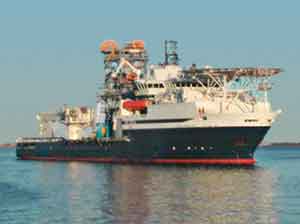 |
Fig. 1. Island Frontier is the first dedicated vessel from which the RLWI system is deployed.
|
|
The dynamically-positioned vessel is operated by Island Offshore. It is equipped with a 70-t module handling tower, 130-t deck-mounted crane, ROV and video unit for operation in 500-m water depths, with up to 5-m (16.5-ft) waves. This newbuild vessel carries a lubricator package from FMC Technologies that is lowered through the moonpool and positioned over the wellhead, Fig. 2. Wireline services are conducted through the lubricator by Maritime Well Service. Standard tasks include production logging, reperforations and downhole equipment replacement. The vessel can work over live wells and can carry 74 people. A second vessel, Island Wellserver, is under construction and due to enter service in 2008.
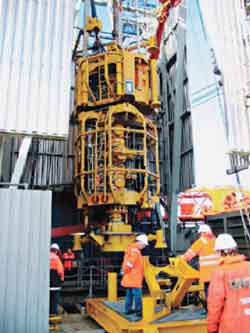 |
Fig. 2. The subsea lubricator package.
|
|
Last year, the alliance partners won a NOK 1.5 billion (US$ 230 million) light well intervention contract that began in April 2006. Contract terms specify that the alliance will provide at least 150 days of service, each year, through 2012.
EXPERIENCE TO DATE
Back in 2003, FMC Technologies first pitched the system to operators for potential usage. That same year, FTI partnered with Prosafe and performed interventions on five wells from the semisubmersible rig, Regalia. There were no monohull vessels available at that time. In 2004, FTI signed an alliance agreement with Island Offshore and Aker Marine Well Services, and spent the year preparing on-deck equipment and waiting for the first monohull, Island Frontier, to be readied. In April 2005, interventions began from Island Frontier under the management of Island Offshore. During the course of the year, the alliance successfully performed interventions on three wells.
In April of this year, the six-year contract with Statoil went into effect. As of early October, the companies had already performed interventions on nine wells at a Statoil-operated field. According to all accounts, the operations have been going extremely well. Average performance has improved to just six days per intervention from the Island Frontier, leaving Statoil "very, very pleased" with the performance of the system. At present, the firms are using a wireline system with a tractor in the end, which can drive into a horizontal well and do either logging services or mechanical change-out of items in the well, or reperforation services and so on. So, operations consist of all the normal things that are usually done with a wireline system.
The effort in perspective. The entire basis for the RLWI business is to improve oil recovery from subsea wells. The reason that Statoil signed the six-year contract with the alliance is that this operator probably has the largest number of wells in the world among older, offshore subsea producers, i.e. wells that have been more than five years in production. That is normally the time when an operator begins to have problems with its wells, when individual well performance is affected.
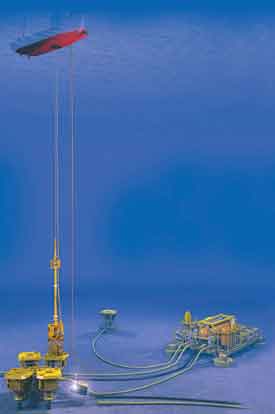 |
Fig. 3. Deployment of RLWI services from a dedicated vessel via wireline to a lubricator package on the floor is currently limited to 5,000 to 5,500 m in a horizontal well. Work is underway to boost the capability to 10,000 m.
|
|
Statoil also elevated its target to achieving a 55% recovery rate from these subsea wells, leaving only 45% of the oil in the ground. The world average, by comparison, is only a 35% recovery factor. So, that would mean leaving 65% of the oil in subsea wells in the ground, a figure unacceptable to Statoil. To improve that 35% means entering the well and physically doing things to it. This includes either reperforating productive zones, closing off zones of producing water or pumping chemicals down the hole to take away calcium, etc. There are many things to do in the well, to make it perform better.
That scenario has been played out for many years – on platform wells and land wells, that's a normal business. On subsea wells this has been a bit unavailable, for lack of a better term, because of the cost of doing interventions. As a reference point, if an operator approves doing a typical well intervention from a marine drilling rig, it is going to cost the company around $10 million to $11 million per intervention. If the intervention is performed from a monohull, as described earlier in this article, then the cost is down to a level of $2.5 million to $3 million.
So, the alliance has now reduced the per-well cost with the RLWI system to below one-third the expense of doing the same intervention from a standard marine rig. At that level, these services are becoming quite competitive.
What is also worth mentioning is that the six-year contract with Statoil guarantees the alliance 150 days of operations per year. But in 2006 already, this number is in the 260-day range. As regards activity in 2007, the minimum guarantee of 150 days has already been increased to around 280 days. These increases only show that there is a fast-growing need for this type of service. This situation is typical of the oil business One has to always demonstrate that a new technology will work, and then people have to become familiar with it and its early history before they actually sign up to use it.
Accordingly, it appears that the RLWI system has moved beyond the testing phase and is moving into more of the actual running of operations and services; in other words, regular business. Obviously, there are things that companies have to do when they fully implement a new technology, and the alliance has perfected a few items, particularly on the running side, to increase the running speed of the system. However, the RLWI system that is now onboard the Island Frontier is operating and running very smoothly. Considering that a complete well intervention has been down to six days per well, defined as from arrival on location until departure from location, the performance is now about as fast as anyone can actually do it. Thus, there is not much more in the system on which to improve.
FURTHER REFINEMENTS
Nevertheless, if one looks forward in time, there are technologies that can be implemented, and the alliance is already working on them. These items are separate, and they are not necessarily part of the Statoil contract. Today, interventions can be operated with normal wireline, which, of course, is slick line and braided wire. Slick line is without any electrical signals going through, and braided wire has electrical lines running through it. However, there are limitations on this method. One of these is that an intervention cannot reach all the way out into the longest wells. The alliance partners and Statoil have done some calculations on how far an intervention can go into a well with various techniques. And with the wireline technique, and the tractor that drags the wire along after itself, it is possible to reach up to 5 to 5.5 km horizontally in a well. Contrast this limit with the fact that the longest well today is more than 10,000 m (10 km). So, there is a gap in distance capability.
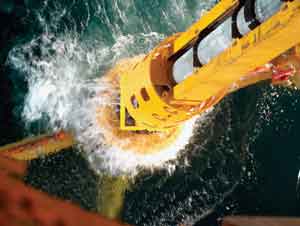 |
Fig. 4. Further refinements of the system include future deployment and operation of services through the lubricator package via composite cable and coiled tubing.
|
|
Composite cable. One way to fix the distance gap is the development of something that FTI refers to as "composite cable." This is a carbon fiber cable with larger cross-section electrical lines inside, so one can drive a heavier tractor. Having that as a part of the system means very little upgrade on the system, but it means that this composite cable must be qualified for use on the wireline system, and FTI is in the process of doing that. Once this is done, companies will be able to reach all the way into the 10,000-m wells.
Coiled tubing deployment. What also is needed in the well intervention mode is coiled tubing. As most everyone knows, coiled tubing is basically small-bore steel pipe that is pushed or pulled into the well by a tractor, and through that pipe, one can pump fluid into the well. A typical use, for example, would be to pump acid to dissolve calcium in a well that is flowing poorly. Whereas the composite cable and wireline technique can probably cover 70% of all well intervention needs, the remaining 30% will have to be addressed by coiled tubing, and this example is one of them.
There are several methods that can be used for that coiled tubing system. The easiest method is to find a vessel that can handle a riser, particularly a stiff, 7-in. riser. This riser can be suspended from the vessel while it is station-keeping, and then coiled tubing can be run into the well. This is about the same as doing it on a rig. There are other techniques or products out in the marketplace. One is called SWIFT, which is a flexible riser that can be attached to a vessel, and then coiled tubing can be run from it. And then there is the SIMPS system that BJ Services and ExxonMobil looked at for some time, which is a subsea coiled tubing unit. The industry has found a good solution in how to deal with coiled tubing for interventions by using a monohull vessel, but this will have to be addressed in the near-term future.
Bringing the new versions to commerciality. If there are two technology steps to take next, one would be to get the composite cable in place to obtain longer reach. Then, the second step would be to get a coiled tubing package in place, so that it can be run for interventions from a monohull vessel. The latter step requires a bit more effort – bringing it to viability and commerciality will take more time than putting the composite cable in place.
Regarding the composite cable, FTI is actually running a program now. In early January or February 2007, FTI will be in The Netherlands on a land well for Shell, to test-run the composite cable there. Later on, the plan is to go offshore and conduct a composite cable intervention from a platform well. So, it is likely that from early 2008, the alliance will be ready to use the composite cable version offshore commercially. In terms of conducting a coiled tubing run from a monohull, this can basically be done today, if a vessel that can handle the riser is available. And this also means having use of a riser that can be a specific size on the vessel. This may seem like an old technology barrier, but it doesn't appear likely that anyone will invest in a large vessel to cover only 30% of the subsea well intervention market. Companies would rather have a smaller, efficient vessel to cover 70% of the market, if one follows their logic.
But this is not the end of the stiff riser version, yet. If one goes to the other end of the range of possibilities, which is a subsea coiled tubing package, where everything is run subsea, that development is a few years away from being viable. It is highly probable that the industry will find something in the middle that all parties can live with, probably in a 2008-2009 timeframe. This also doesn't mean that everyone has to go to a large vessel, because that is something that can be done today. Everyone is a little bit vague on the coiled tubing portion, because it's easy to do it the costly way, but it's not so easy to do it very cost-efficiently – that is what the alliance is struggling with right now.
Engineers think they can handle it in some areas of the world; i.e., in certain weather conditions, they think it can operate with a rigid riser solution, probably from a 140-m vessel. The vessel that the alliance is running with now, the Island Frontier, is 104 m. From the supply side, the alliance partners would very much like to go into the coiled tubing area. There certainly will be more work carried out on the matter, to be able to combine these services.
Vessel differences. Island Offshore is building a second vessel dedicated to well intervention services. The alliance's vessels are roughly similar – both have a moonpool, both have a tower, both have a skidding arrangement and so on. However, there are some differences, principally two things. The main difference is that the newest vessel (Island Wellserver) is slightly larger at 116 m, compared to the Island Frontier at 104 m. With more length goes extra width, so the Island Wellserver is a more stable vessel. In addition, the vessel is more tailor-made for integrated well intervention services. For example, today, there is one cabin from where subsea equipment is run, and another cabin from where wireline services are run. On the new vessel, functions would be integrated, and all services would be run from one operating station. These are the enhancements that the alliance is implementing on the vessel side of the system. And by integrating these elements into the vessel, itself, the modules don't take up a large space. Furthermore, since Island Wellserver is generally a more stable vessel, the companies will be able to operate during a longer part of the year. Although the system can run more efficiently, because more of the services are integrated, in principle the alliance is using essentially the same subsea wireline equipment.
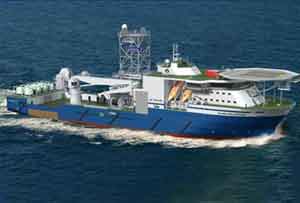 |
Fig. 5. As the second dedicated vessel for RLWI deployment, Island Wellserver will be longer and wider than Island Frontier. It will also feature more integrated components that take up less deck space.
|
|
PARALLEL ULTRA-DEEP EFFORT
There is a parallel technology being pursued, on which the alliance is very much focused, and that is to prepare the system for ultra-deep waters, typically down to 2,000 m. To do that, the partners will have to simplify the umbilical system to surface and use composite cable technology. Part of the sealing mechanism around this wireline system is composed of grease, which is injected between rubber seals squeezed around the wireline. To go very deep would require too long a distance between the vessel and the subsea wellhead on these grease injection lines and, therefore, slow response times.
One needs to switch to subsea grease injection to compensate for the depth. In addition, the use of composite cable would further simplify the sealing mechanism for the deepwater system. Thus, there are small adjustments that need to be made so that the system will be very efficient in ultra-deep waters. That is a technology train on which the alliance is obviously running very fast, so that it is prepared to deploy the system quickly, once companies decide that it is needed. Today, there is no existing contract for subsea well intervention in the deepwater areas of the world. All the contracts that are discussed have been, or will be, in the North Sea. But the partners envision that the demand in deep waters will eventually materialize.
Yes, people have approached the alliance with requests to work on an ultra-deep system design, so that decisions on components can be made. And the partners are obviously working with these companies. But there are no contracts out for such deepwater areas as offshore West Africa or Brazil. A couple of reasons for that are: 1) The wells are still young in these areas, particularly in West Africa; and 2) If operators have plenty of rigs in the area, and they can just bring in a rig to do a particular well intervention, then it seems likely that they would rather do that than employ a full workover intervention vessel. Yet, going forward, West Africa will have more and more subsea wells that will become older, and Brazil should have quite a large market, because they have many subsea wells in place already. Most of these wells are oil wells, meaning they should require workovers, but that demand hasn't happened yet.
CONCLUSIONS
In summation, the RLWI system has seen good progress over the last couple of years, and the technology has already proven itself to a large degree. As the system enters a more commercial phase with Statoil, the additional experience will yield further refinements, such as the use of composite cable and coiled tubing for subsea well interventions. In addition, the potential growth market for such interventions in deeper waters, offshore places like West Africa and Brazil, will ensure the continued development and deployment of an ultra-deep version of the system. 
|
THE AUTHOR
|
 |
Tore Halvorsen is vice president for FMC Technologies and general manager of their Eastern Hemisphere subsea systems business, based in Kongsberg, Norway. He was appointed to the vice president's post in March 2004. Previously, he served as managing director of FMC Kongsberg Subsea AS since 1994. Mr. Halvorsen joined FMC in 1993 as director of Subsea Systems for FMC Kongsberg Subsea.
|
|
|








